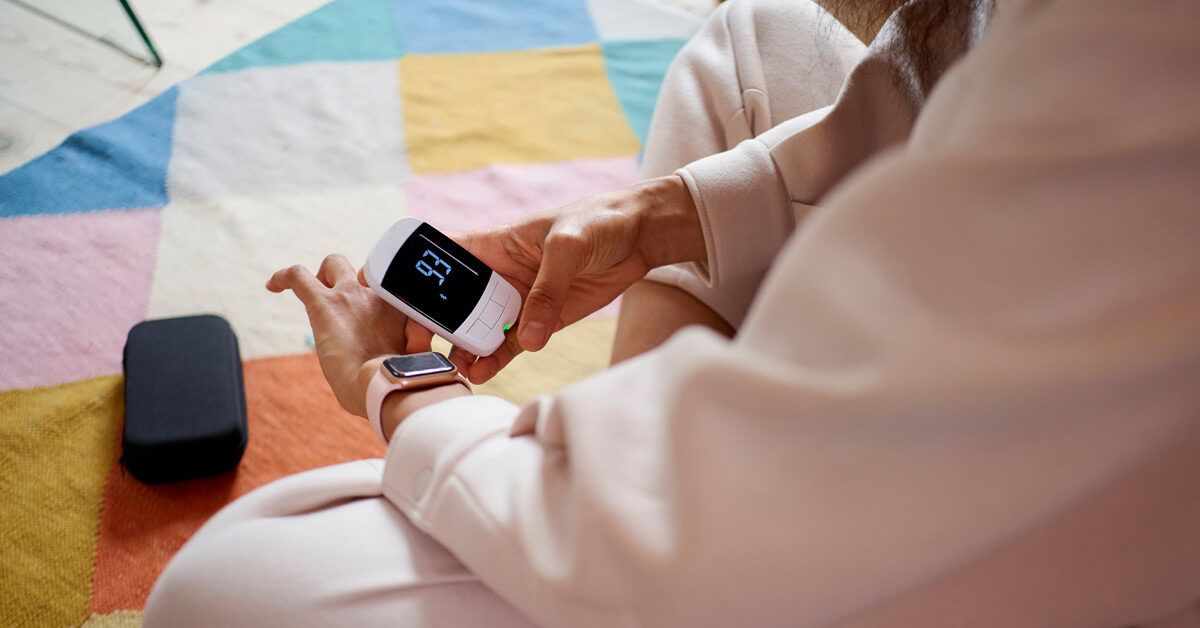
- Select a language for the TTS:
- UK English Female
- UK English Male
- US English Female
- US English Male
- Australian Female
- Australian Male
- Language selected: (auto detect) - EN
Play all audios:
Bezzy communities provide meaningful connections with others living with chronic conditions. Join Bezzy on the web or mobile app.
When you have diabetes, insulin is vital to help keep your blood sugar levels in check. If you have type 1 diabetes, you must inject insulin daily. Those with type 2 diabetes may also
require insulin injections to maintain their blood sugar levels.
This article is not a replacement for medical advice from a healthcare professional. It only gives a general overview of how to determine how much insulin to administer.
Not all insulin types are the same. Pharmaceutical manufacturers make long-acting, intermediate-acting, and short-acting insulin options. If you do inject insulin, the best way to start a
treatment plan is to contact your doctor.
In people who do not have diabetes, their bodies release insulin in response to the foods they eat. This is because many foods contain carbohydrates. Some examples include bread, sweets,
fruits, and even vegetables.
Your body breaks down carbohydrates into smaller building blocks, like glucose. You need insulin to use this glucose for energy. If your body cannot make or use insulin effectively, you need
to inject it to process your food for energy.
Calculating how much insulin to take is usually based on two considerations:
Calculating a bolus dose is where insulin administration can get tricky. When you give yourself insulin, you’re estimating how many units of insulin it will take to process the carbohydrates
you eat.
The University of California, San Francisco states that, as a general rule, 1 unit of rapid-acting insulin will process anywhere from 12 to 15 grams of carbohydrates.
A bolus dose may also be used to correct high blood sugar. In general, 1 unit of insulin lowers your blood sugar by about 50 milligrams per deciliter (mg/dL).
Since the human body is so complex, not all people will process insulin the same way. Factors like time of day, stress levels, and physical activity can make these numbers more difficult to
predict.
Because of this, you’ll probably start off giving yourself insulin based on numbers for the average person. After seeing how these numbers help you manage your blood sugar, you may have to
adjust based on how your body uniquely responds to the insulin you administer.
Now that you know the how and why behind insulin dosing, let’s consider how you may calculate your insulin needs.
You’ll usually give yourself an insulin dose around your meals since that’s when you take in carbohydrates. You will also typically check your blood sugar.
If you eat about the same amount of carbohydrates each day, you may be able to consistently inject the same amounts of insulin outside of special occasions. It takes time to find out how
your body best responds to insulin.
Let’s say you check your blood sugar before a meal, and it’s 170. You’ll need 1 unit of fast-acting insulin to adjust to your target of 120.
If you plan to eat a meal that has 60 grams of carbohydrates, you’ll need to give yourself 6 units of insulin to adjust for your meal.
If your child needs help learning to calculate their insulin needs, Children’s Healthcare of Atlanta has created a helpful worksheet just for this.
Combine both of these when considering how much insulin to inject.
For this chart, we’ll assume your premeal blood sugar target is 120 mg/dL and that 1 unit of fast-acting insulin will decrease your blood sugar by 50 points.
If your blood sugar is below 70, do not administer insulin. Instead, immediately consume 15 grams of carbohydrates.
If your blood sugar is 300 and above, check your ketones and contact your doctor immediately.
For this chart, we’ll assume you take 1 unit of rapid-acting insulin for every 15 grams of carbohydrates.
The amount of rapid-acting insulin needed to process the carbs you eat is known as the insulin-to-carb (I:C) ratio. Learn more about the I:C ratio.
How diabetes affects your body can vary greatly from person to person and day to day and whether your diabetes is type 1 or type 2.
When establishing your insulin routine with your doctor, be sure to discuss your lifestyle honestly so they can help create the best plan for you. Your doctor might advise different
calculations than those listed above to help fine-tune your dosage.
Many things can affect how your body processes carbohydrates and insulin. According to the American Diabetes Association, these include:
Managing your diabetes can cause many highs and lows. Both can represent a medical emergency. Call 911 or local emergency services if you experience the following:
Learn more about living with diabetes from Healthline’s top resources.
DKA is serious and can be life threatening. A doctor must treat it.
If you have moderate or high ketones, call your doctor. If you can’t reach your doctor and you’re having any of the following symptoms, call 911 or go to the nearest emergency room:
Insulin will lower your blood sugar. If your blood sugar is already low, you should not inject more insulin.
Symptoms indicating that your blood sugar is too low include sweating, dizziness, blurred vision, and significant fatigue. If this happens, try to consume rapid-acting carbohydrates, like
sugared sodas, fruit juice, or glucose tablets, to get your blood sugar levels back up quickly.
People who use insulin or sulfonylurea medications to manage blood sugar should consider having a glucagon emergency kit on hand at all times. It’s a nasal spray or injection that treats
severe hypoglycemia.
With severe hypoglycemia, you usually can’t swallow drinks or foods with glucose. Instead, glucagon treatment is used to raise your blood sugar level.
Glucagon emergency kits are available by prescription. If you don’t have a kit already, talk with your doctor about getting one.
You’ll want to teach your friends and family how to administer glucagon, because it’s often not possible to use it yourself during a severe hypoglycemic event.
Call 911 if a person has a seizure, experiences decreased consciousness, or faints due to low blood sugar.
You can calculate the amount of insulin you take before meals by considering your blood sugar before you eat and the number of carbohydrates you take in during your meal. Read the “How much
to take” section to see our sample calculation and example.
The average person will take about 1 unit of fast-acting insulin for every 12 to 15 grams of carbohydrates consumed.
There is some variation to this, depending on factors such as how sensitive you are to insulin.
For some people, this range is 1 unit for every 6 grams of carbohydrates. For others, it’s 1 unit for every 30 grams of carbohydrates. This value is known as the insulin-to-carb (I:C) ratio.
Your doctor can help you learn the I:C ratio that’s suitable for you.
You will typically inject a longer-acting or basal insulin at night. This insulin will work for 24 hours or more and affect blood sugar during the night and between meals during the day.
You may adjust this dose on a regular basis depending on your blood sugar before bed.
Injecting insulin is not a safe approach to weight training. However, some bodybuilders will inject it as a performance-enhancing drug. They believe injecting insulin will allow energy in
the form of glucose to enter their cells so they can build more muscle.
This practice is unsafe. It can lead to severe and potentially life threatening hypoglycemia, according to 2019 research.
Do not take insulin unless you have diabetes. If you do have diabetes, talk with your doctor about how your training regimen may affect your blood sugar levels.
Human growth hormone (HGH) is another hormone that bodybuilders may inject in an attempt to gain muscle. Some bodybuilders will inject both HGH and insulin. This is an unsafe practice that
doctors do not recommend.
It can take time to understand how your body best responds to insulin correction when you have diabetes.
Having a plan for regular dosing and knowing the signs and symptoms of high and low blood sugar can help you safely manage your diabetes. If you have questions, contact your doctor to ensure
you have the best plan for managing your blood sugar.
The insulin sensitivity factor tells you how many points, in milligrams per deciliter (mg/dL), your blood sugar will drop for each unit of insulin…
Here are some do's and don'ts to pay attention to as you learn how to effectively manage your diabetes with insulin.
Some people use insulin to help build muscle. This article details its uses, effects, and potentially serious side effects.
If not treated, high insulin levels can lead to serious health problems. Here are 13 diet and lifestyle changes you can make to reduce your levels.
Clinicians may use an estimated average glucose (eAG) to help people with diabetes better understand their A1C result.
Watch this video to learn about important questions to ask your doctor about diabetes.
Type 1 and type 2 diabetes are completely separate and unique conditions. Take the quiz and test your knowledge of the difference.
A fasting glucose test requires you not to eat or drink anything but water for at least 8 hours. Here are some guidelines and tips to help you prepare.
Professional chef Jen Gomez reviews what to look for when trying to pick the perfect avocado.
You may need to manage your blood sugar levels if you're living with a health condition like diabetes. Here are 14 evidence-backed tips to help you…









